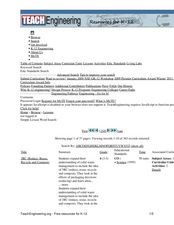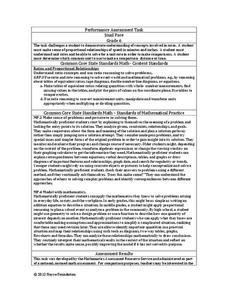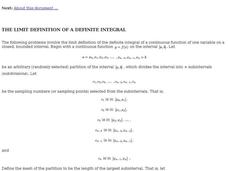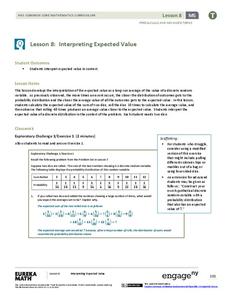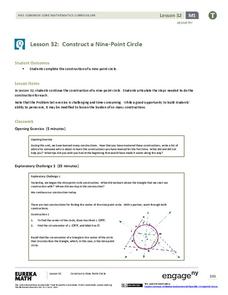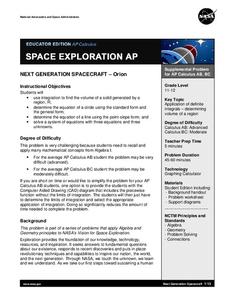Curated OER
Tessellation Design And Construction
Young scholars study the basic elements and concepts of the visual art's perceptual component - such as shape, line and color. They create tessellations that foster problem solving and reflective thinking.
Curated OER
Picnic Possibilities
Fourth graders plan a picnic using weather data. Using accumulated weather data from various sources, they create a graph of the weather conditions in their region for a given period of time. Students interpret this data to predict the...
Curated OER
Charging Up, Charging Down: Exponential Models
Students collect and analyze voltage data. In this math lesson plan, students investigate exponential functions using the TI and a Voltage Probe. They graph their data and analyze it using a table.
Curated OER
Time for Design
Students are introduced to the design process used in engineering. They compare and contrast this process with the steps followed in the scientific method. Students then participate in a brainstorming session that asks them to design a...
Noyce Foundation
Snail Pace
Slow and steady wins the race? In the assessment task, scholars calculate the rates at which different snails travel in order to find the fastest snail. Hopefully, your class will move much more quickly in finishing the task!
Curated OER
The Limit Definition of a Definite Integral
In this calculus instructional activity, students calculate the derivative and integral of different functions. They use interval to mark the beginning and end of their calculations. There are 15 questions with an answer key.
Curated OER
I'm Done! What Now?
You can use these lesson plans to give your high ability math students something challenging to do when they finish early!
EngageNY
Interpreting Expected Value
Investigate expected value as a long-run average. The eighth installment of a 21-part module has scholars rolling pairs of dice to determine the average sum. They find aggregate data by working in groups and interpret expected value as...
Curated OER
Counting on Art
Explore the life and painting style of African-American artist Horace Pippin by looking carefully at its parts, then create a "secret number" painting for a classroom counting book.
Curated OER
Designing a Playground!
Students design their own playground equipment. In this design lesson, students take pictures of equipment they like and make a class pictograph of their favorite ones. They investigate the design, research equipment around the world,...
Curated OER
No More Traffic Jams: Lesson 3
Traffic is a very real concern for any Urban dweller. After watching a video showing various traffic issues and solutions, learners group up to discuss and develop innovative traffic solutions of their own. They explore vocabulary and...
Alabama Learning Exchange
Sky High
How are skyscrapers built? What does it take to make a structurally sound building? How can one work within a budget to complete a building project? These guiding questions will be investigated and answered within a hands-on lesson....
Curated OER
Dino-Myte Spreadsheet
Do your learners like dinosaurs and theme parks? An ambitious lesson invites learners to put together a plan for supplying dinosaurs for a new theme park. Pupils work together in groups to come up with their plan, which must include a...
Illustrative Mathematics
Molly's Run
A simple lesson with a lot of support behind it. Your learners will find out how long it takes Molly to run a mile by choosing their solution method. The activity can be used as a lesson or as an independent assignment. Preface with...
Curated OER
Benefits of Indoor Plants
Learners diagram a plant. For this Science lesson, students explore the concept of photosynthesis focusing on the oxygen production. Learners calculate the amount of plants needed to filter the air in their classroom.
Curated OER
Rolling Twice
Rolling dice is the best way to show your learners how probability comes in to play. Although this lesson does not specify an activity, your mathematicians can try this probability with real dice to calculate their experimental...
Curated OER
Geometric Abstraction
Students create an abstract work of art that is made by repeating geometric shapes and lines, write concise instructions to reproduce the work of art and reproduce someone else's artwork via written instructions.
Curated OER
Planning a Garden Using a Grid
Third graders plan for a garden. In this garden planning lesson, 3rd graders investigate the use of a grid to accurately map out and plan for a vegetable garden. Students predict the space requirements for different vegetables.
EngageNY
Construct a Nine-Point Circle
There are an infinite number of points on a circle; can you find nine of them? After putting together a nine-point circle, pupils use constructions and their knowledge of triangle segments to determine the center of the circle. Learners...
Curated OER
Calculating Your Foodometer
Young scholars explore environmental issues by completing a food production class activity. In this carbon footprint instructional activity, students discuss the types of foods they eat, where they come from and what types of methods are...
Curated OER
NEXT GENERATION SPACECRAFT-Orion
Learners investigate the volume of a solid. In this calculus lesson, students use integration to find the volume of a solid generated by a region, the Orion crew module.
Curated OER
Identify the Shape
10 this geometry worksheet, learners identify the different angles created by polygons and name the shape created based on the number of sides. There is an answer key.
Curated OER
Think Differently
Students will think differently to solve a problem and create a personal action plan to reduce GHG emissions. They evaluate their plan using a decision grid and sign a pledge committing to taking personal action.
Curated OER
Pam Wu's Teaching Portfolio
Students explore the concept of long division. In this long division lesson, students use multiples to work out division problems. Students also complete a worksheet for students to practice this new skill.





